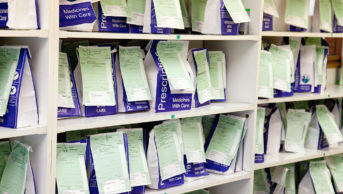
PSNC
The government has proposed adjusting Category M drug reimbursement prices to ensure that pharmacy contractors are receiving equitable access to the medicines margin.
The Department of Health and Social Care’s (DHSC’s) proposals, which were published for consultation on 23 July 2019, suggest allowing community pharmacists to recoup less money on Category M generics for which a branded version exists and more money from all other Category M drugs.
It claims that adjusting which drugs pharmacists recoup their costs from will ultimately mean “all pharmacy contractors have equitable access to [the] medicine margin”, which is worth £800m annually.
Under the current system, some branded generics are priced below the Category M reimbursement price for generic versions of the same drug, making them look cheaper to prescribers, because Category M reimbursements do not apply to branded drugs.
According to the proposal document, this encourages clinical commissioning groups (CCGs) and GPs “to prescribe the product by brand rather than generically”.
However, the branded generic “may well be more expensive to the NHS because it does not contribute (or contributes very little) to the £800m medicine margin” distributed to community pharmacy annually under the national contract. The shortfall in the margin owed to pharmacists would then need to be taken from elsewhere.
The document added that in the CCGs which recommend prescribing the branded generic “because they see it as cheaper to them”, pharmacy contractors do not receive a fair share “as they do not retain medicine margin on brands”.
“To address the problem outlined above, we propose that we change the distribution of medicine margin added to generic medicines in Category M,” the proposals said.
“We propose to add less medicine margin to those generic medicines for which branded equivalents are available and that are priced below the generic medicine, and as a consequence add more medicine margin on all other Category M medicines.”
Mike Hewitson, managing director of Beaminster Pharmacy in Dorset, said that the proposals could see the DHSC “eliminate branded generics, which are a major problem for pharmacies up and down the country”, adding that the proposals are “a welcome move”.
“The more branded generics that are used, the less profit is delivered to pharmacies, so Category M has to go up more to compensate for the fact that pharmacies are not receiving their fair share of the income,” he said.
“This is an attempt to try and address that imbalance and stop CCGs from gaming the system.”
The consultation’s launch comes after the Pharmaceutical Services Negotiating Committee (PSNC) announced on 15 July 2019 that Category M reimbursement prices are to increase by £15m per month from August 2019 to ensure that the overall amount of margin delivered during the 2019/2020 financial year is the agreed annual sum of £800m.
Gareth Jones, head of corporate affairs at the National Pharmacy Association, told The Pharmaceutical Journal: “The current system does not deliver the margin element of funding equitably across the sector. The branded generics issue continues to exacerbate the situation.
“This must be addressed so that independent contractors have a fair share of the funding available to deliver the pharmacy service. The proposed changes are complex, and we will study the ideas in detail to identify whether the stated aim of delivering fairer funding will be delivered.”
The proposals could also see a split in the deduction scale, with one for generics and one for branded medicines, which the government said will, “on average, improve equitable access to the medicine margin for community pharmacies”.
The deduction scale is an assumed amount of discount received so that pharmacy contractors do not have to calculate and declare discount received on each item dispensed.
Speaking during a webinar on the five-year community pharmacy contract, Mike Dent, director of pharmacy funding at the PSNC, said the changes to the deduction scale are “of particular interest to us”.
“This will help even funding distribution across contractors and it will also stop contractors feeling like they’re dispensing brands at a loss,” he said, adding that the changes set out in the consulation are “wide-ranging” and “will impact the entire supply chain”.
If approved, the changes to Category M drug reimbursement and the deduction scale will both be made by April 2020.
The government consultation is open until 17 September 2019, after which the DHSC will consult with the PSNC on how the new margins will be calculated.


